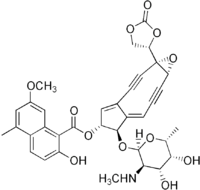Neocarzinostatin
| Neocarzinostatin chromophore[1] | |
|---|---|
 | |
| IUPAC name (1aS,5R,6R,6aE)-6-{[(2R,3R,4R,5R,6R)-4,5-Dihydroxy-6-methyl-3-(methylamino)tetrahydro-2H-pyran-2-yl]oxy}-1a-(2-oxo-1,3-dioxolan-4-yl)-2,3,8,9-tetradehydro-1a,5,6,9a-tetrahydrocyclopenta[5,6]cyclonona[1,2-b]oxiren-5-yl 2-hydroxy-7-methoxy-5-methyl-1-naphthoate | |
| Identifiers | |
| CAS number | [79633-18-4 [79633-18-4]] [9014-02-2], Neocarzinostatin |
| ChemSpider | 21106457 |
| Jmol-3D images | {{#if:COc7cc1c(ccc(O)c1C(=O)O[C@@H]3\C=C4\C#C[C@@]5(OC5C#CCC4[C@H]3O[C@H]2O[C@H](C)[C@H](O)[C@H](O)[C@H]2NC)C6COC(=O)O6)c(C)c7|Image 1 |
| |
| |
| Properties | |
| Molecular formula | C35H33NO12 |
| Molar mass | 659.64 g/mol |
| Pharmacology | |
| Excretion | Renal |
| Except where noted otherwise, data are given for materials in their standard state (at 25 °C (77 °F), 100 kPa) | |
| Infobox references | |
Neocarzinostatin is a macromolecular chromoprotein enediyne antibiotic with anti-tumoral activity secreted by Streptomyces macromomyceticus.
It consists of two parts, a labile chromophore (bicyclic dienediyne structure shown at right) and a 113 amino acid apoprotein to which the chromophore is tightly and non-covalently bound with high affinity (Kd ~ 10-10 M). The chromophore is a very potent DNA-damaging agent; it is very labile and the role of the apoprotein is to protect it and release it to the target DNA. Opening of the epoxide under reductive conditions present in cells creates favorable conditions for a Bergman cyclization, leading to a diradical intermediate and eventually double DNA strand cleavage. Other members of the neocarzinostatin group of antibiotics are macromomycin, actinoxanthin, kedarcidin and maduropeptin.
As a medicine it is among the most potent, and in Japan only it has been used against liver cancer clinically.
References
- ↑ Shoji Kobayashi, Makiko Hori, Guang Xing Wang, and Masahiro Hirama (2006). "Formal Total Synthesis of Neocarzinostatin Chromophore". J. Org. Chem. 71 (2): 636–644. doi:10.1021/jo052031o+S0022-3263(05)02031-1. PMID 16408974.